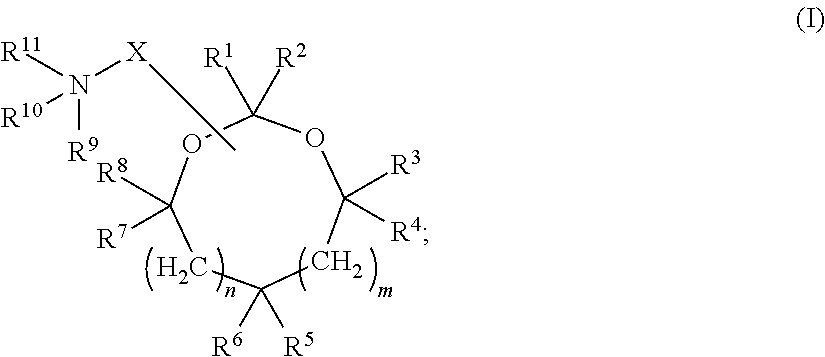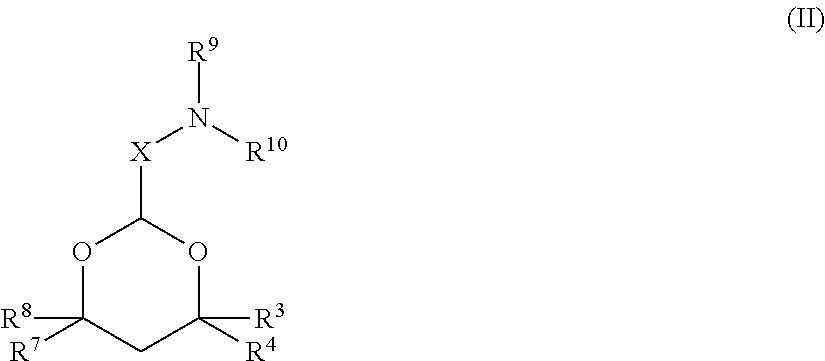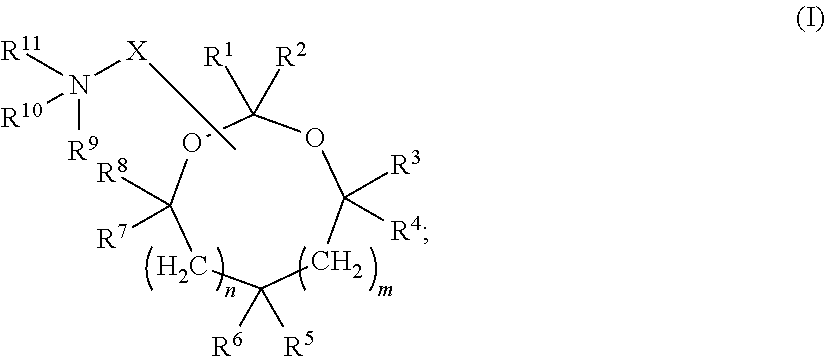Novel cationic lipids and methods of use thereof
a technology of cationic lipids and lipids, which is applied in the field of improved lipidtherapeutic nucleic acid compositions, can solve the problems of reducing affecting the survival rate of the construct, and affecting the activity of the construct, so as to achieve stable circulation and suppress the expression of hepatitis c virus
- Summary
- Abstract
- Description
- Claims
- Application Information
AI Technical Summary
Benefits of technology
Problems solved by technology
Method used
Image
Examples
example 1
Synthesis of Cationic Lipids (8) and (9) of the Present Invention
[0415]
Meldrum's Acid (1)
[0416]Malonic acid (41.6 g, 0.4 mol) was suspended in anhydrous acetone (33.2 mL, 0.46 mol) with H2SO4 (1 mL) and the mixture cooled (0° C.). The reaction mixture was then treated, dropwise, with acetic anhydride (47.2 mL, 0.50 mol) and stirred (2.5 h). While chilled (0° C.), the mixture was filtered and the filter cake washed with cold (−20° C.) ethanol (100%). The crude crystals were purified via recrystallization (2×) from ethanol (100%) to yield Meldrum's acid (1) as stark-white needle-like crystals (22.3 g, 39%). FW 144.13, C6H8O4.
(11Z,14Z)-methyl 3-oxoicosa-11,14-dienoate (2)
[0417]Linoleoyl chloride (25.0 g, 83 6 mmol) was added, dropwise, to a cooled (0° C.) solution of Meldrum's acid (1) (13.3 g, 92.0 mol) and pyridine (14.8 mL, 184 mmol) in CH2Cl2 (180 mL) and the solution was allowed to warm (rt, 16 h). The reaction mixture was washed with an equal volume of HCl (5%, aq., 2×), dried (N...
example 2
[0426]Synthesis of Cationic Lipid (12) of the Present Invention
(6Z,9Z,29Z,32Z)-20-((8Z,11Z)-heptadeca-8,11-dien-1-yl)-21-hydroxyoctatriaconta-6,9,29,32-tetraen-19-one (10)
[0427]To a cooled (−40° C.) solution of N,N,-di-isopropylamine (462 μL, 3.27 mmol) in THF (9 mL) was added nBuLi (1.45 mL, 3.63 mmol as a 2.5M solution in hexanes). After stirring (40 min) the solution was cooled (−78° C.) and treated with di-linoleylmethylketone (1.50 g, 2.85 mmol, neat) dropwise. After stirring (40 min) the newly generated lithium enoloate was added to a cold (−78° C.) solution of linoleyl aldehyde (804 mg, 3.04 mmol) in THF (4 mL). After stirring (1 h, −78° C.) the mixture was quenched by the addition of sat. aq. NH4Cl, then extracted with EtOAc, dried (Na2SO4), filtered and concentrated. The crude material was subjected to chromatography (0.5%→1% EtOAc-hexanes) to yield (6Z,9Z,29Z,32Z)-20-((8Z,11Z)-heptadeca-8,11-dien-1-yl)-21-hydroxyoctatriaconta-6,9,29,32-tetraen-19-one (10) (1.50 g, 62%) as ...
example 3
[0430]Lipid Encapsulation of siRNA
[0431]All siRNA molecules used in these studies were chemically synthesized and annealed using standard procedures.
[0432]In some embodiments, siRNA molecules were encapsulated into serum-stable lipid nanoparticles (LNP) composed of the following lipids: (1) the lipid conjugate PEG2000-C-DMA (3-N-[(-methoxypoly(ethylene glycol)2000)carbamoyl]-1,2-dimyristyloxypropylamine); (2) one or more cationic lipids or salts thereof (e.g., cationic lipids of Formulae I or II of the invention and / or other cationic lipids described herein); (3) the phospholipid DPPC (1,2-dipalmitoyl-sn-glycero-3-phosphocholine) (Avanti Polar Lipids; Alabaster, A L); and (4) synthetic cholesterol (Sigma-Aldrich Corp.; St. Louis, Mo.) in the molar ratio 1.4:57.1:7.1:34.3, respectively. In other words, siRNA molecules were encapsulated into LNP of the following “1:57” formulation: 1.4% PEG2000-C-DMA; 57.1% cationic lipid; 7.1% DPPC; and 34.3% cholesterol. It should be understood that...
PUM
| Property | Measurement | Unit |
|---|---|---|
| Temperature | aaaaa | aaaaa |
| Diameter | aaaaa | aaaaa |
| Diameter | aaaaa | aaaaa |
Abstract
Description
Claims
Application Information
 Login to View More
Login to View More - R&D
- Intellectual Property
- Life Sciences
- Materials
- Tech Scout
- Unparalleled Data Quality
- Higher Quality Content
- 60% Fewer Hallucinations
Browse by: Latest US Patents, China's latest patents, Technical Efficacy Thesaurus, Application Domain, Technology Topic, Popular Technical Reports.
© 2025 PatSnap. All rights reserved.Legal|Privacy policy|Modern Slavery Act Transparency Statement|Sitemap|About US| Contact US: help@patsnap.com



